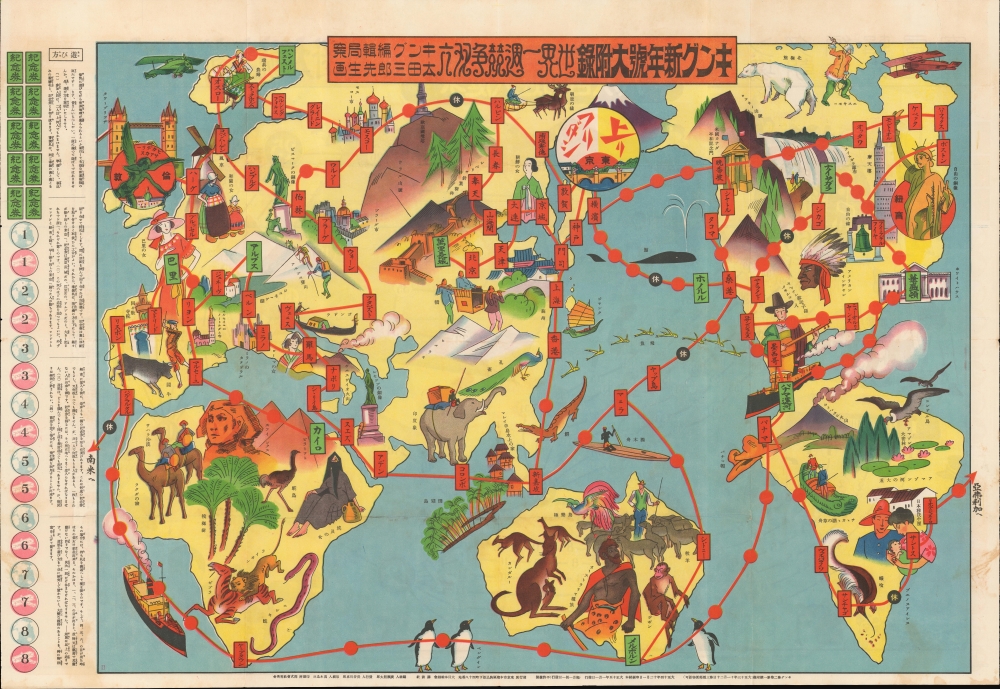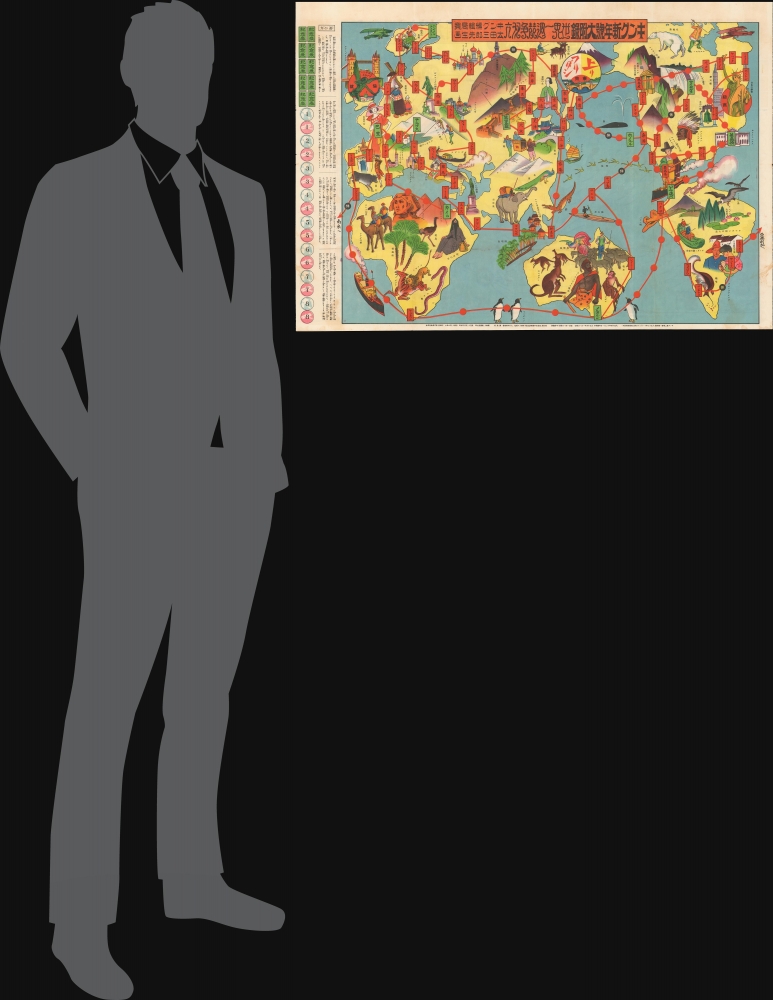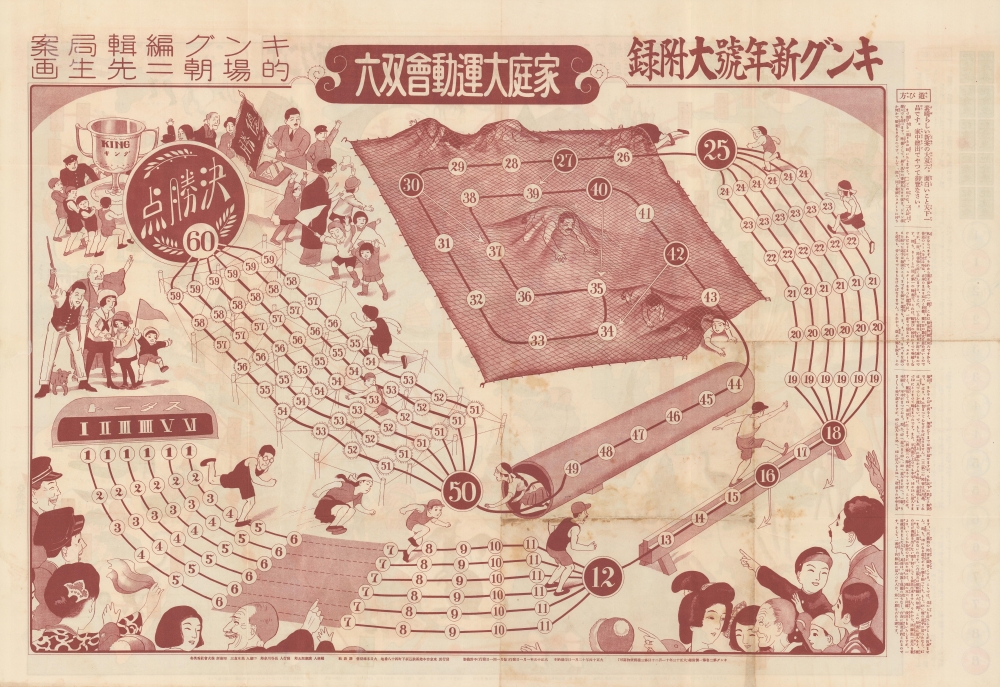1926 Saburo Ota Pictorial World Map Sugoroku Map
RoundtheWorld-ota-1926-2
Title
1926 (dated) 21.5 x 30.5 in (54.61 x 77.47 cm)
Description
A Closer Look
The game board is an allegorical map of the world centered on Japan. The continents are amorphous but recognizable. Vignette illustrations depict cultural figures, architectural wonders, flora, fauna, and Japanese people engaging with the world. Three cities are highlighted: Tokyo, the starting point or furi-dashi, and New York and London, optional endpoints or agari. The verso features another game entitled 'Family Athletic Meet.'Japan Finds a Place on the Global Stage
This map illustrates Japan's emergence from an insular feudal nation to a rising power on the world's social, military, and economic stage. The 1853 arrival of Commodore Perry and his forced opening of Japan transformed Japan's vision of itself, breaking the illusion that it was the sole repository of civilization and underscoring the truth that it was, in fact, well behind Western powers. What followed was the Meiji Restoration, a major reorganization of government, a reassertion of imperial power, and a drive towards aggressive industrial and social modernization. Japan's victory over Imperial Russia in the Russo-Japanese War (1904 - 1905) marked the first victory in war by an Asian power over a European Power, an achievement that established Japan as a global power.International Japan
This map, embraced in the colorful format of a game, places the Japanese on the world stage. It was made for the youth of Japan. It encouraged them to think of themselves as part of an increasingly global culture, capable of traveling, migrating, and interreacting as social equals anywhere. A Japanese woman here shops for fashion in Paris, and a Japanese family emigrates to South America, representing a wave of immigration that would soon become a powerful political force.Japanese Influence on Western Pictorial Cartography
This and other Japanese maps of the period significantly influenced the development of pictorial cartography in England, France, and the United States in the first half of the 20th century. This map brings to mind the sophisticated pictorial maps that French commercial illustrator Lucian Boucher produced for Air France in the 1950s. Boucher's work resembles this map in style, design, and substance. Although little has been written about the influence of Japanese manga on the rise of pictorial and commercial cartography in the West, the connection here is recognizably linear.Sugoroku
The essence of the game, generally known as sugoroku, is akin to the western board game Snakes and Ladders. Historically, there are two variants of sugoroku, one similar to backgammon and the presently offered 'snakes and ladders' variant. This version of the game appeared as early as the 13th century and was popularized by the rise of printing technology, especially in the Edo and Meiji periods, leading to the production of high-quality, visually arresting gameboards. A standard sugoroku board has a starting point, the furi-dashi, and a winding or spiral path terminating at the agari or finish line. The gameplay, not unlike 'Snakes and Ladders,' is a race to the finish.'Publication History and Census
This map was published in Japan on New Year's Day, 1926, or Taisho 15, the final year of the Taishō's Era. It was drawn by Saburo Ota (太田三郎) and published by Dai Nippon Odankai Kodansha (式会社講談社). It was issued as a supplement to the magazine Kingu (キング; vol.2, no.1).CartographerS
Saburo Ota (太田三郎, December 24, 1884 - May 1, 1969) was a Japanese painter and commercial illustrator active in the first half of the 20th century. Ota was born in Aichi Prefecture. He studied both Western, under Kuroda Seiki (黒田清輝, 1866 - 1924), and traditional Japanese, under Terasake Hiromi (寺崎広業, 1866 - 1919), painting styles. He then traveled extensively in the 1920s, where he was influenced by the cubist and fauvist movements. He worked as an illustrator under the name Yanagi Kimishima (君島柳三) More by this mapmaker...
Kodansha (式会社講談社, 1909 - Present), also known as Dai Nippon Odankai Kodansha, is a Japanese publishing house founded in 1909 by Seiji Noma (野間淸治). Seiji founded Kodansha as a spin-off from the Dai-Nippon Yūbenkai (Greater Japan Oratorical Society) and produced the literary magazine Yūben as its first publication. The name Kodansha, a derivative of the defunct magazine Kōdan Club (Storytelling Club), in 1911, which it merged with the Dai-Nippon Yūbenkai. In 1925, Kodansha launched King (キング) , the first magazine to sell 1,000,000 copies in its first printing. Kōdansha published several other magazines including Women's Club (婦人倶樂部) and Boy's Club (少年倶樂部) and had become a major shaper of Japanese culture and public opinion by the 1930s, controlling 70% of the magazine market. Kōdansha suffered difficulties during the war period, due to both intense censorship and the 1938 death of both Noma Seiji and his son, Noma Hasashi (野間恒), within weeks of one another. Still, the company survived the wartime era and, after a period of difficulties during the U.S. Occupation due to Kōdansha's endorsement of militarism, benefitted from a postwar publishing revival. Although King and other magazines ceased publication in the postwar period, Kōdansha branched into other areas, including manga and music recording, and is now the largest publisher in Japan. Learn More...






